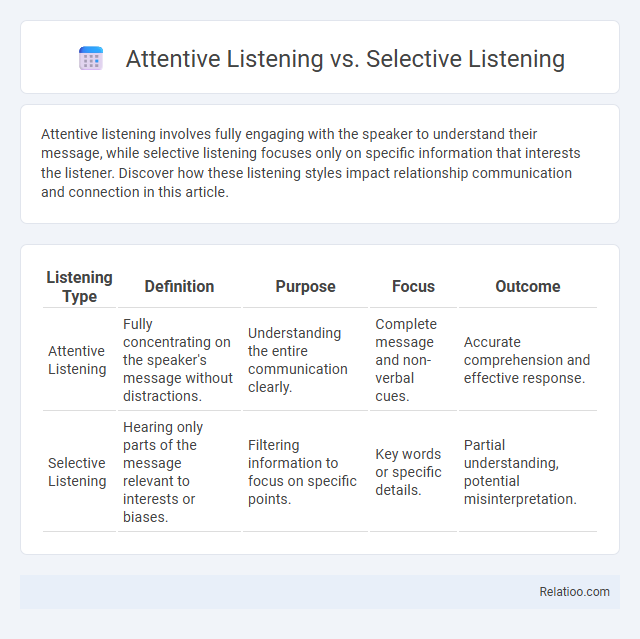Attentive listening involves fully engaging with the speaker to understand their message, while selective listening focuses only on specific information that interests the listener. Discover how these listening styles impact relationship communication and connection in this article.
Table of Comparison
| Listening Type | Definition | Purpose | Focus | Outcome |
|---|---|---|---|---|
| Attentive Listening | Fully concentrating on the speaker's message without distractions. | Understanding the entire communication clearly. | Complete message and non-verbal cues. | Accurate comprehension and effective response. |
| Selective Listening | Hearing only parts of the message relevant to interests or biases. | Filtering information to focus on specific points. | Key words or specific details. | Partial understanding, potential misinterpretation. |
Introduction to Attentive and Selective Listening
Attentive listening involves actively focusing on the speaker's message, interpreting both verbal and nonverbal cues to fully understand the information being conveyed. Selective listening filters specific parts of the conversation based on personal interest or relevance, often leading to partial comprehension. Your ability to distinguish between these listening styles enhances communication effectiveness and helps prevent misunderstandings.
Defining Attentive Listening
Attentive listening involves fully concentrating on the speaker's message, processing both verbal and nonverbal cues to understand the intent and emotions behind the words. Unlike selective listening, which filters information based on personal interests, attentive listening requires an open and unbiased mindset, ensuring no critical details are missed. Developing your attentive listening skills enhances communication effectiveness and fosters stronger interpersonal connections.
Understanding Selective Listening
Selective listening involves focusing on specific information while ignoring other parts of a conversation, which can lead to missing critical details and misunderstandings. In contrast, attentive listening requires full engagement with the speaker's message, leading to better comprehension and relationship building. Disconnect occurs when a listener disengages completely, resulting in communication breakdowns and reduced trust.
Key Differences Between Attentive and Selective Listening
Attentive listening involves fully focusing on the speaker's message, capturing both verbal and nonverbal cues to understand the content deeply, while selective listening filters information based on personal interests or biases, often leading to missed or ignored details. Disconnect occurs when you mentally or emotionally disengage from the conversation, resulting in a lack of comprehension or response. Understanding these differences helps improve communication by encouraging you to engage more actively and reduce misunderstandings.
Psychological Factors Influencing Listening Styles
Psychological factors such as attention span, emotional state, and cognitive biases heavily influence attentive listening, selective listening, and disconnect. Attentive listening requires active engagement and empathy, while selective listening often stems from personal interests, preconceived notions, or stress, filtering out information deemed irrelevant. Disconnect occurs when overwhelming emotions, mental fatigue, or a lack of motivation impede your ability to process or retain auditory information effectively.
Benefits of Attentive Listening
Attentive listening enhances comprehension and strengthens interpersonal relationships by fully engaging with the speaker's message, promoting empathy and trust. Unlike selective listening, which filters information based on personal biases, attentive listening allows for a complete and accurate understanding of the speaker's intent. This skill reduces misunderstandings and fosters effective communication in both personal and professional settings.
Consequences of Selective Listening
Selective listening limits your understanding by filtering information to fit preexisting beliefs, often causing misunderstandings and missed opportunities for meaningful communication. This behavior can lead to weakened relationships and reduced collaboration because important details and emotional cues are ignored. Unlike attentive listening, selective listening blocks the full exchange of ideas, creating barriers that disconnect you from others' perspectives and insights.
Practical Examples of Each Listening Style
Attentive listening involves fully focusing on the speaker, such as when a manager carefully listens to an employee's feedback during a performance review to understand concerns and improve workflows. Selective listening occurs when a person hears specific parts of a conversation, like tuning into key project deadlines during a team meeting while ignoring off-topic discussions. Disconnect happens when someone mentally checks out, for example, a student zoning out during a lecture and missing crucial information necessary for exams.
Strategies to Improve Attentive Listening Skills
Attentive listening involves fully concentrating on the speaker, understanding their message without distraction, contrasting with selective listening where only specific information is heard, and disconnect where engagement is absent. Strategies to improve attentive listening skills include maintaining eye contact, minimizing external distractions, and practicing reflective feedback to confirm understanding. Developing mindfulness techniques and actively summarizing points during conversations further enhances focus and retention of information.
Choosing the Right Listening Approach for Effective Communication
Attentive listening requires your full focus on the speaker's message, capturing both verbal and non-verbal cues for comprehensive understanding. Selective listening involves filtering key information relevant to your needs, which can streamline communication but risks missing important details. Disconnect occurs when your attention drifts away from the conversation, hindering effective communication and reducing overall engagement.

Infographic: Attentive Listening vs Selective Listening
 relatioo.com
relatioo.com